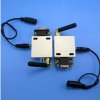Thanks for the pointers, Craig
However, I'm still struggling my way through this this! Grrrrr!!! I have already followed the tut that you pointed me to.... and like you, I am using a usb to serial interface (/dev/ttyUSB0)
I may try from scratch again.... and possibly try again with the FreeBSD box.... and Windows box!
But for the Pi my ./webapps/controller/WEB-INF/classes/config.properties for Russound is included below - I've commented out the ip and ports (and tried with them uncommented)
# RUSSOUND CONFIGURATION:
#
# Configuration related to Russound amplifier
##
# IP-Address of the RS232 Serial gateway if used. The gateway has to support TCP mode
###russound.ip=192.168.100.8
##
# Port of RS232 Serial gateway to use
###russound.port=1234
##
# KeypadId IF NOT 0x70 (default). Specify as Hex without leading "0x" eg. "71"
russound.keypadId=^M
##
# If the Russound is connected directly to a serial port of controller use device name here eg. /dev/ttyS0^M
# If a serial device is specified the IP settings are ignored^M
russound.serialDevice=/dev/ttyUSB0
##
# If a pollingInterval is given, that means an extra thread is started which polls the device for the status^M
# valid values: 5000, 5s, 1m, 2h (no letter=milliseconds, s=seconds, m=minute, h=hour)^M
russound.statusPollingInterval=^M
#
OpenRemote explains how to install the native libraries (referenced below for others) :
http://www.openremote.org/pages/viewpage.action?pageId=22413658#OpenRemote2.0HowTo-InstallControlleronRaspberryPi-6.InstallNativeLibrariesforARM
6. Install Native Libraries for ARM
While OpenRemote is written in Java to be portable across different operating systems and CPU architectures, there are a few places where we need to reach to the native layers to access serial or USB ports, etc.
By default, these native libraries are compiled for x86 CPU architecture. You will need to update them to ARM binaries when running on Raspberry Pi.
Serial port access from OpenRemote Controller is done with RXTX library. To download and install ARM based binary of RXTX, execute the following commands:
> sudo apt-get install librxtx-java
> cp /usr/lib/jni/librxtxSerial.so \[path to OpenRemote Controller]/\
OpenRemote-Controller-2.0.2/webapps/controller/WEB-INF/lib/native/librxtxSerial.so

